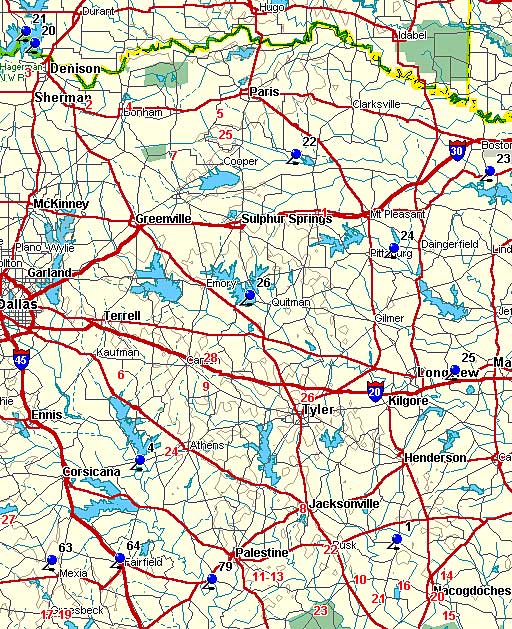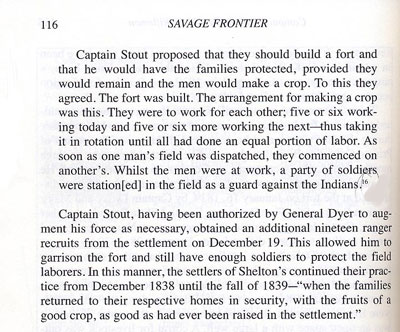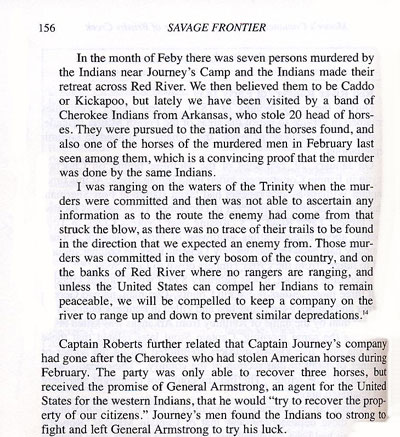|
Uncommemorated Historical Sites  (Blue
Pinpoints with Black Numbers)
(Blue
Pinpoints with Black Numbers)
Listed Alphabetically
79-Anderson-Faulkenberry Slayings | 63-Coleman's Rangers Attack Tawakonis | 20-Fort Coffee | 25-Fort Crawford | 26-Fort Le Dout | 21-Fort Preston | 22-Fort Saint Louis de Carloretta | 24-Fort Sherman | 4-Fort Trinidad | 23-Le Poste des Cadodaquious | 1-Mission Nuestra Senora de Los Dolores de Los Ais | 64-Colonel Moore's Ranger Expedition
Forest Trail Brochure
Historical Markers (Numbered in Red)
Listed Alphabetically
27-Battle Creek Burial Ground | 14-Battle of Nacogdoches | 28-Battle of the Neches | 26-Camp Ford | 25-Camp Rusk | 9-Cherokee Chief Bowles | 22-Cook's Fort | 11-Fort Houston | 12-Fort Houston | 13-Fort Houston Cemetery | 4-Fort Inglish | Fort Inglish Museum | 3-Fort Johnson | 7-Fort Lyday | 17-Fort Parker | 18-Fort Parker Memorial Park | 19-Fort Parker State Historic Site | 2-Fort Warren | 8-Killough Massacre | 6-King's Fort | 10-Lacy's Fort | 20-Mission Nuestra Senora de Guadalupe | 21-Mission Nuestra Senora de la Purisma Concepcion | 23-Mission San Francisco de los Tejas | 24-(Mission) Nuestra Senora Del Pilar de Bucareli | 16-Presidio Nuestra Senora de Los Dolores (Presidio Dolores) | 1-Ripley Massacre | 5-Shelton's Fort | 15-Stone Fort | Stone Fort Museum
Marker 1-Ripley Massacre
Marker Title: Ripley Massacre
City: Mt. Vernon
County: Franklin
Year Marker Erected: 1986
Marker Location: US 67 at Ripley Creek Crossing, 4 mi. east of Mt. Vernon
Marker Text: Ambrose Ripley and his wife Rachel (Wood) brought their family
to Texas in 1837, settling near here in what was then Red River County.
They established their home near the Nacogdoches Road (Cherokee Trace)
and a stream now known as Ripley Creek. On April 10, 1841, while Ripley
was away, a band of Indians attacked his farmstead, killing first his
eldest son who was plowing in the field. Mrs. Ripley and five children
were killed trying to reach a canebreak and one infant died when the house
was burned. Two of Ripley's daughters eluded the Indians and made it to
a neighboring farm. Charles Black and Charles S. Stewart led a group of
settlers north in pursuit of the band. Near the Sulphur River, they encountered
Indians, who may or may not have been involved in the massacre, and attacked
them, killing several. The Ripley family massacre was an isolated incident
in this area, but it proved to be a rallying point for increased frontier
defenses and for support of the anti-Indian policies of Texas President
Mirabeau B. Lamar. The attack also influenced the formation of a militia
unit under the leadership of Gen. Edward H. Tarrant and Cols. James Bourland
and William C. Young to rid the area of Indians. Texas Sesquicentennial
1836 - 1986
Marker 2-Fort Warren
Marker Title: Fort Warren
City: Savoy
County: Fannin
Year Marker Erected: 1968
Marker Location: from Savoy take US 82 east .5 miles to R.O.W.
Marker Text: (site six miles north) First settlement and fort In Fannin
County. Built in 1836 by Abel Warren, Indian trader from Arkansas, to
protect his trading post. Constructed of bois d'arc wood, the structure
had a two-story guardhouse at all four corners. Kiowa, Tonkawa, Caddo,
Wichita and other Indians came here to trade furs for paint, knives and
trinkets. In Civil War, Fort Warren was a transport and food supply center,
where goods were sent to Confederate Indian refugees and troops in Indian
Territory (to the north) and to soldiers in Louisiana and Arkansas. (1968)
Marker 3-Site of Fort Johnson
Marker Title: Site of Fort Johnson
City: Pottsboro
County: Grayson
Year Marker Erected: 1936
Marker Text: Established by William G. Cooke in 1840 as a part of the
defense of the Military Road from Red River to Austin. Named in honor
of Colonel Francis W. Johnson (1799-1888). Commander of the Texas army
at the capture of San Antonio, December 10, 1835. Place of rendezvous
for the Snively Expedition which set out April 25, 1843. The settlement
in the vicinity was known as Georgetown.
Marker 4-Vicinity of Fort Inglish
Marker Title: Vicinity of Fort Inglish
City: Bonham
County: Fannin
Year Marker Erected: 1972
Marker Location: near corner of Lipscomb and 9th St.
Marker Text: (exact original location unknown) Spot where settlement of
town of Bonham began. On 1,250-acre land grant of Texas Republic to Bailey
Inglish (1797-1867), former Miller County, Ark., sheriff who led train
of settlers traveling by oxcart to this site in 1837. Here they built
a log stockade and blockhouse with gun ports for use in community defense.
In a typical fight (1841), the Indians were repulsed, but captured two
young boys hunting cows near the fort. (The boys returned later.) Called
Bois d'Arc in 1840, town was renamed (1843) to honor Texas War for Independence
hero, Col. James Butler Bonham (1807-1836).
Thanks to Dori Leatherwood from the Bonham Chamber for providing the following article on Fort Inglish.
Fort Inglish - During the early years of the Republic of Texas Fannin County residents lived in constant danger of Indian attack, and Fort Inglish was a frequent refuge for settlers on the western edge of the Red River frontier.
It was built in the summer of 1837 by Bailey Inglish in the form of a single blockhouse, sixteen feet square and topped by an overhanging story twenty-four feet square, probably surrounded by a log stockade. Fort Inglish was on grounds now occupied by a Veterans Administration center, north of East Ninth Street and east of Lynn street, in downtown Bonham. Although it was private, Fort Inglish played a role in several official campaigns against the Indians by the Army of the Republic of Texas. In November 1838 it served as the rendezvous point for the militia brigade of Gen. John H. Dyer during the Rusk-Dyer Indian expedition, and in October 1840 Col. William G. Cooke's troops straggled into Fort Inglish after the near-disaster of the Military Road expedition. After the removal of the Indian threat to white settlement in Northeast Texas in the early 1840s, however, Fort Inglish fell into disrepair and was eventually dismantled.
Marker 5-Site of Shelton's Fort
Marker Title: Site of Shelton's Fort
City: Roxton
County: Lamar
Year Marker Erected: 1978
Marker Location: CR 24050 off FM 2675, about 4 mi. SE of Roxton
Marker Text: In 1837 Jesse Shelton (1782-1855) built a log house and stockade
at this site. It served as a way station for pioneer travelers and a stronghold
for settlers fleeing Indian raids. Shelton's Fort was designated a Republic
of Texas Post Office in 1840. It was also the site of Methodist worship
services. Shelton served on the committee to select the first Lamar County
Seat and was one of the county's first justices of the peace. In 1851
George McGlasson bought the property. The settlement that grew up in this
vicinity became known as McGlasson community.
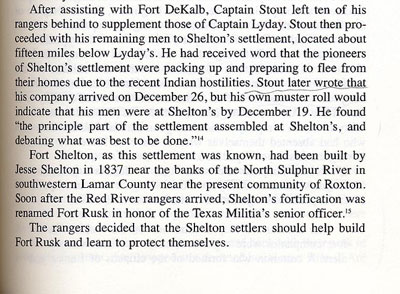
Marker 6-King's Fort
Marker Title: King's Fort
Address: 607 N. Clay St.
City: Kaufman
County: Kaufman
Year Marker Erected: 1997
Marker Text: An early frontier fort of the Republic of Texas, King's Fort
was built in June of 1840 by a survey party led by Warren A. Ferris, then
Nacogdoches County surveyor. Dr. William P. King of Mississippi financed
the expedition and accompanied Ferris. Because the fort was located on
a favorite hunting ground for area Indians, settlement was delayed several
years by fear of attacks. The fort, with its four cabins and a stockade,
was used primarily as a way station and place of refuge for travelers.
William King continued his efforts to lure settlers to the area, buying
area land until shortly before his death in 1841. When Charles F. Mercer's
colonists began to arrive in the vicinity between 1844 and 1846, King's
Fort became the center of a dispersed community known as Kingsborough.
Kaufman County was formed in 1848. The town lost its bid to be the county
seat then and in 1850, but won a crucial election in 1851. The name of
Kingsborough was changed to Kaufman according to state law. Though her
legal claim to the title was disputed, King's widow, Frances Tabor, is
credited with the donation of 150 acres of the Kingsborough tract to the
county seat for a townsite. (1997)
Marker 7-Site of Fort Lyday
Marker Title: Site of Fort Lyday
City: Ladonia
County: Fannin
Year Marker Erected: 1963
Marker Location: from Ladonia take FM 64 east 4 miles to FM 904; then
north on FM 904 4 miles to R.O.W.
Marker Text: Early Texas pioneer Isaac Lyday built a fort in this area
soon after settling here in 1836. The compound consisted of living quarters,
storerooms, and a large community well. As many as eighty families gathered
inside the fort during Indian attacks. Due to an increase in Indian raids,
the settlement was almost abandoned until Texas Ranger Captain William
B. Stout came in 1838 to organize a Ranger force. Lyday was elected captain
of the company and served until 1839. Fort Lyday continued to shelter
settlers until Indian trouble subsided after the Civil War. More
Marker 8-Killough Massacre
Marker Title: Killough Massacre
City: Jacksonville
County: Cherokee
Year Marker Erected: 1965
Marker Location: 7 miles northwest of Jacksonville on US 69, north to
FM 855 then southeast on CR 3405 to monument site on CR 3411
Marker Text: In this area, on October 5, 1838, the Killough, Wood and
Williams families were attacked by hostile Indians and Mexicans: 18 were
either killed of carried away; 8 escaped on horseback; 3 women with a
baby fled on foot and were saved on third day by a friendly Indian. Was
biggest Indian depredation of East Texas. Bodies of the victims found
were buried here.
General Rusk ordered East Texas captains to raise new Ranger companies. The worst massacre suffered in the new settlements occurred on the heels of the order spurring the troops to action.
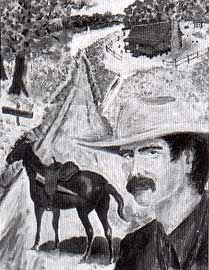
Elisha Clapp

Elias Vansickle escaped Cordova's rebels and reported in January, 1839, that Mexican troops and East Texas Indians planned immediate attacks on the white settlements and further confirmed a suspected Cherokee had participated in the massacre.
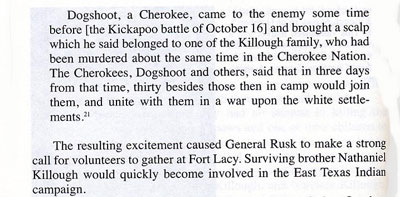
Savage Frontier II
Marker 9-Cherokee Chief Bowles
Marker Title: Bowles, Cherokee Chief
Address: 19 mi. SE to CR 4923, 2.5 mi. N
City: Canton
County: Van Zandt
Year Marker Erected: 1936
Marker Location: From Canton, take SH 64 about 19 mi. SE to CR 4923, follow
signs N about 2.5 mi. to marker.
Marker Text: On this site the Cherokee Chief Bowles was killed on July
16, 1839 while leading 800 Indians of various tribes in battle against
500 Texans. The last engagement between Cherokees and whites in Texas.
Marker 10-Site of Lacy's Fort
Marker Title: Site of Lacy's Fort
City: Alto
County: Cherokee
Year Marker Erected: 1936
Marker Location: about 2.5 miles West of Alto on SH 21
Marker Text: Built before 1835 as a home and trading post by Martin Lacy,
Indian agent for the Mexican government. Used as a place of refuge after
the massacre of the Killough family, October 5, 1838.
Marker 11-Fort Houston
Marker Title: Fort Houston
City: Palestine
County: Anderson
Year Marker Erected: 1936
Marker Location: about 2 mi. from Palestine off US 79S on FM 1990 just
past tracks, behind Palestine Concrete.
Marker Text: A fort and stockade built about 1836 on the public square
of the town of Houston (then in Houston County), as a protection against
the Indians, by order of General Sam Houston, Commander-in-Chief of the
Texan armies. The town was abandoned in 1846 for Palestine, the new seat
of Anderson County, the fort about 1841. The site is now a part of the
historic home of John H. Reagan, which is called Fort Houston.
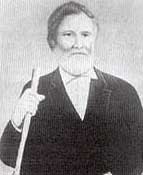 |
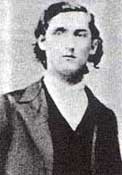 |
Captain William Turner Sadler |
Garrison Greenwood |
Captain Sadler's company of ten Rangers, all residents of present Houston and Anderson counties, were enrolled for a three month tour of duty beginning January 1st, 1836. In March, the men were assigned the task of constructing a blockhouse that would become known as Fort Houston. By the time the Rangers began the job, several cabins had already been partially completed there by the local settlers and they welcomed the protection. Regional Ranger Superintendent Garrison Greenwood described the situation to Sam Houston in a letter dated March 7th:
This place and the adjoining frontier is exposed from the Indians who inhabit in great numbers this part of the country-the Ionis, the Caddos, Anadarkos, the Kickapoos, the Ayish, and the Kichais and Tawakonis are supposed to be not far north and frequently through the country. These all range the woods and now and then steal horses, and with them there has that I know of been as yet no settled principal of action nor of friendship established-which leaves us without any grounds of confidence to expect anything more of them than has ever been the practice of the savage when the times and circumstances afforded a favorable opportunity of venting their malignant spleen.

Major James Smith
In September, 1836, Major James Smith was ordered to recruit four companies
to replace Greenwood's Ranger battalion. They finished construction on
Fort Houston as well as reinforcing Clapp's Blockhouse, Brown's Fort,
Lacy's Fort and Parker's Fort.
More on Fort Houston
Marker 12-Fort Houston
Marker Title: Fort Houston
City: Palestine
County: Anderson
Year Marker Erected: 1969
Marker Location: Intersection of US 79 and FM 1990, 2 mi. south of Palestine,
.25 mi. north of Ft. Houston on FM 1990 just past tracks.
Marker Text: (site one-fourth mile south) A stockade and blockhouse of
the Republic of Texas. Built in 1835-1836 to protect settlers who founded
Houston, a pioneer town, now in Anderson County. Friendly Indians would
come to trade at the site, but wary settlers often slept inside the 25-foot-square
blockhouse, built of heavy logs. Trappers bought supplies there and men
from Houston formed one of the first Ranger units in Texas. The fort defended
a large area of the frontier, 1836-1839, but it was abandoned about 1841.
The site later became part of home of John H. Reagan, Texas Statesman.
More on Fort Houston
Marker 13-Fort Houston Cemetery
Marker Title: Fort Houston Cemetery
Address: Harcrow Road, west of Loop 256
City: Palestine
County: Anderson
Year Marker Erected: 1985
Marker Location: Harcrow Road, west of Loop 256, Palestine
Marker Text: In 1835, Joseph Jordan and William S. McDonald donated about
500 acres of land in this area for the town of Houston, later known as
Fort Houston. An early map of the townsite shows a section designated
as a "public burying ground." The infant child of the Rev. Peter
Fullinwider, an early Protestant minister in Anderson County, is said
to have been the first to be interred here. The oldest marked grave, that
of Dr. James Hunter, is dated 1840. The Fort Houston Cemetery is the only
remaining physical evidence of the early frontier town, which was abandoned
after Palestine was made Anderson County seat in 1846. Victims of diseases,
Indian massacres, and other hardships that faced early Texas settlers
are buried here. A special soldiers' plot, marked with a large boulder,
contains the graves of soldiers of the Republic of Texas. Two veterans
of the Battle of San Jacinto, John W. Carpenter and James Wilson, are
buried in unmarked graves. The burial site of General Nathaniel Smith,
a War of 1812 veteran, is also located in the soldiers' plot. The Fort
Houston Cemetery remains in use as a public burial ground and as a reminder
of the early history of the area. (1985)
Marker 14-Battle of Nacogdoches
Marker Title: Battle of Nacogdoches
City: Nacogdoches
County: Nacogdoches
Year Marker Erected: 1979
Marker Location: corner of Fredonia and El Camino Real
Marker Text: (August 2, 1832) One of the opening actions of the Texas
War for Independence, this battle occurred soon after settlers drove out
the Mexican garrisons at Anahuac and Velasco. In 1832 Col. Jose de las
Piedras, in command of over 300 soldiers here, ordered the residents to
surrender all firearms. Citizens of Nacogdoches and other East Texas towns
resisted by forming the "National Militia," commanded by James
W. Bullock. When Piedras refused to support the constitution of 1824,
the militia marched toward the Mexicans on the square and the Mexicans
opened fire. In hand-to-hand combat, the militia took the stone fort and
several nearby structures, but the Mexicans continued to hold Piedras'
headquarters in the red house. Adolphus Sterne showed San Augustine "redlanders"
how to outflank the Mexicans. Piedras' men fled during the night and were
captured August 3 by militiamen near Loco Creek. Fighting ended after
the Mexicans arrested their leader at John Durst's home. A peace treaty
was signed on August 6. Piedras lost 47 men. Four Texans died, including
the alcalde of Nacogdoches, Encarnacion Chireno. Because of this incident,
Mexican troops were never again stationed in East Texas, leaving settlers
free to meet and air their grievances.
Marker 15-Old Stone Fort
Marker Title: Old Stone Fort
City: Nacogdoches
County: Nacogdoches
Year Marker Erected: 1963
Designations: Recorded Texas Historic Landmark
Marker Location: SFA University, on Alumni Dr.
Marker Text: --
Stone Fort Museum
Museum Name: Stone Fort Museum
Mailing Address: P. O. Box 6075 SFASU
Street Address: Corner of Alumni & Clark Blvd., SFA Campus
City: Nacogdoches
County: Nacogdoches
Zip Code: 75962
Area Code: 409
Phone: 568-2408
Marker 16-Presidio Nuestra Senora de Los Dolores (Presidio Dolores)
Marker Title: Presidio Nuestra Senora de Los Dolores
City: Douglass
County: Nacogdoches
Year Marker Erected: 1936
Marker Location: about 6 mi. south of Douglass on FM 225 at junction w/CR
789
Marker Text: Built by Capt. Domingo Ramon, 1716. Repaired and enlarged
by Marquis of San Miguel de Aguayo, 1721. Abandoned about 1730. Built
by the Spanish government as a fort and headquarters for soldiers to guard
the east Texas missions and the borders of the New Philippines.
Marker 17-Fort Parker
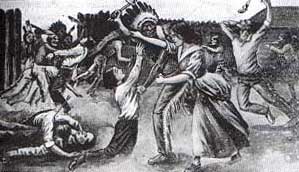
Parker's Fort Massacre drawing published in 1912 in DeShields' Border
Wars of Texas.
Marker Title: Fort Parker
Address: Of FM 1245, in Fort Parker Historical Park
City: Groesbeck
County: Limestone
Year Marker Erected: 1965
Marker Location: Fort Parker Historical Park, off SH 1245 on park rd.
35, N of Groesbeck.
Marker Text: Built 1834 for protection from Indians. Named for leaders
who bought first Predestinarian Baptist church body to Texas: Elder Daniel
Parker; his father, Elder John; bothers Jas. W., Benjamin, Silas, John.
Also here were Kellogg, Frost, Nixon, Duty and families on May 18, 1836,
raiding Comanches killed Benjamin, John and Silas Parker, Samuel and Robert
Frost and others; captured Elizabeth Kellogg, Rachel Plummer and son James,
and Sila's children, John and Cynthia Ann in captivity, Cynthia Ann married
Chief Peta Nacona; her son, Quanah, was last Comanche Chief. With her
baby, Prairie Flower, in 1860 she was captured by Texas Rangers. She,
the baby and Quanah are buried at Fort Sill.
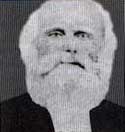
Luther Thomas Martin Plummer
His pregnant wife and son were both
taken hostage by the Comanches from
Parker's Fort.
Marker 18-Fort Parker Memorial Park
Marker Title: Fort Parker Memorial Park
Address: Off FM 1245, in Fort Parker Historical Park.
City: Groesbeck
County: Limestone
Year Marker Erected: 1964
Marker Location: Off FM 1245, on Park Rd. 35, Fort Parker Historical Park,
N of Groesbeck Marker Text:--
Marker 19-Old Fort Parker State Historic Site
Museum Name: Old Fort Parker State Historic Site
Mailing Address: Rt. 3 Box 746
Street Address: State Park Rd. 35
City: Groesbeck
Zip Code: 76642
Area Code: 254
Phone: 729-5253
County: Limestone
Marker 20-Mission Nuestra Senora de Guadalupe
Marker Title: Site of the Mission Nuestra Senora de Guadalupe
Address: North and Mullen St.
City: Nacogdoches
County: Nacogdoches
Year Marker Erected: 1936
Marker Text: A Spanish outpost founded in 1716 by the pioneer Franciscan
Antonio Margil de Jesus as a means of civilizing and Christianizing the
Nacogdoches Indians. Abandoned temporarily due to the French incursions
from Louisiana in 1719. Restored by the Marquis of Aguayo in 1721. Abandoned
permanently in 1773. Its deserted buildings formed a nucleus for the settlement
of Nacogdoches in 1779 by Antonio Gil y Barbo.
Marker 21-Mission Nuestra Senora de la Purisma Concepcion
Marker Title: Mission Nuestra Senora de la Purisma Concepcion
Address: about 7 mi. south of Douglass via FM 225, then south on CR 789,
take left before Goodman Bridge and continue for one miles.
City: Douglass
County: Nacogdoches
Marker Location: about 7 mi. south of Douglass via FM 225, then south
on CR 789, take left before Goodman Bridge and continue for one mile.
Marker Text: Established by Franciscan missionaries in 1716 with the hope
of civilizing and Christianizing the Indians of the region. Abandoned
temporarily due to the French incursions from Louisiana in 1719. Restored
by the Marquis of Aguayo in 1721. Removed to the Colorado River in 1730
and finally situated on the San Antonio River in 1731.
Marker 22-Cook's Fort
Marker Title: Cook's FortCity: Rusk
County: Cherokee
Year Marker Erected: 1936
Marker Location: about 3 miles south of Rusk on FM 241
Marker Text: Named in honor of Joseph T. Cook; native of North Carolina; Early settler in Nacogdoches; Owner of land on which a military company under Captain Black built a fort never attacked by Indians; On adjacent land, James Cook built a store and blacksmith shop; About them a village grew up; Population in 1846, 250; After establishment of Rusk, inhabitants moved there.
Marker 23-Mission San Francisco de Los Tejas
Marker Title: Mission San Francisco de Los Tejas
City: Weches
County: Houston
Year Marker Erected: 1971
Marker Location: Mission San Francisco de Los Tejas State Park, 1 mile
from park gate near mission replica
Marker Text: --
Marker 24-(Mission) Nuestra Senora Del Pilar de Bucareli
Marker Title: Bucareli
City: Midway
County: Madison
Year Marker Erected: 1972
Marker Location: From Midway take SH 21 about 4 mi. E to marker on N side
of Rd, just W of Trinity bridge.
Marker Text: In this vicinity, at Paso Tomas on the Trinity, was the Spanish
town Nuestra Senora del Pilar Del Bucareli (1774-1779) Indian troubles
had caused Spain to move Louisiana colonists to Bexar (San Antonio). These
people, however, pled to return to East Texas, and secured the consent
of Viceroy Antonio Maria Bucarelo. Led by Gil y Barbo (1729-1809), they
built at the Trinity crossing a church, plaza, and wooden houses, and
grew to a town of 345 people. But ill luck with crops, a few Comanche
raids, and river floods sent the settlers farther east. Again led by Ybarbo,
they rebuilt the old town of Nacogdoches, 1779.
Marker 25-Old Camp Rusk
Marker Title: Old Camp Rusk
County: Delta
Year Marker Erected: 1967
Marker Location:
Marker Text: (Southern Boundary, 1861) A training camp of Texas 9th Infantry
Regiment, Confederate States of America. Named for Gen. Thomas Rusk, early
Texas leader, activated, 1861, when Texas State Senator Sam Bell Maxey
resigned office, raised militia known as Lamar Rifles of Light Infantry.
Other local militia combined with Maxey's to form 9th Regiment. Regiment
left here, Dec. 1861; fought many battles including famous ones at Shiloh,
Corinth, Mobile, Chickamauga, Atlanta, New Hope Church, Missionary Ridge,
Murfreesboro and Perryville.
Marker 26-Camp Ford
Marker Title: Camp Ford
City: Tyler
County: Smith
Year Marker Erected: 1957
Marker Location: 2 mi. NE of Tyler on US 271
Marker Text: On this site during the Civil War was located Camp Ford,
the largest prisoner of war compound for Union troops west of the Mississippi
River. Named in honor of Col. John S. "Rip" Ford who originally
established a training camp here in 1862. It was converted in the summer
of 1863 to a prison camp. It first consisted of four to five acres enclosed
by a stockade sixteen feet high. In the spring of 1864 following the Confederate
victories at Mansfield, Louisiana and Mark's Mills, Arkansas, the enclosure
was doubled to accommodate the large influx of prisoners. Approximately
4700 Federals were confined here during this period. This overcrowded
condition was somewhat relieved through a series of prisoner of war exchanges
between the North and the South. Union soldiers representing nearly one
hundred different regiments plus sailors from gunboats and transports
were confined here. In addition there were imprisoned Union sympathizers,
spies and even Confederate deserters. The prisoners constructed their
own shelters ranging from log huts and burrows called "shebangs"
to brush arbors and tents made of blankets. A spring, located about 100
yards southwest of this marker, furnished an ample supply of good water.
Their meager rations, essentially the same as that of their guards, usually
consisted of beef and corn meal and were sometimes supplemented by vegetables
purchased from nearby farms. Although escape attempts were frequent, very
few were successful due to the long distance to Union lines and the difficulty
in eluding the tracking hounds used by the Confederate guards. Even though
conditions were primitive it compared favorably with the other Civil War
prison camps. Camp Ford continued to serve as a prison until the surrender
of the Trans-Mississippi Department in May, 1865. It was later destroyed
by Federal occupation troops.
Marker 27-Battle Creek Burial Ground
Marker Title: Battle Creek Burial Ground
Address: SH 31, W of Dawson 2 mi.
City: Dawson
County: Navarro
Year Marker Erected: 1966
Marker Location: From Dawson, go west on SH 31 about 2 miles
Marker Text: A surveying party of 25 Texans ran into about 300 Kickapoo
Indians on a buffalo hunt; failing to heed warning to leave, the Texans
were ambushed on October 8, 1838. Only seven survived, and four of these
were wounded. After the escape, they came back to bury their comrades
in a common grave. (1966)
Marker 28-Battle of the Neches
Marker Title: Battle of the Neches
City: Colfax
County: Van Zandt
Year Marker Erected: 1968
Marker Location: Roadside park on Hwy. 20, 5 mi E of Colfax
Marker Text: (Site 15 miles southeast) Main engagement of Cherokee War;
fought July 15 and 16, 1839, between 800 Indians (Including; Delawares
and Shawnees) and 500 troops of the Republic of Texas. An extraordinary
fact is that David G. Burnet vice president of the Republic; Albert Sidney
Johnston, secretary of war; and two other high officials took active parts
in the fighting. When killed, Chief Bowles, aged Cherokee leader, carried
a sword given him by Gen. Sam Houston. After the defeat of the tribes,
they scattered, thus virtually ending Indian troubles in the settled eastern
part of Texas. (1968) More
 Uncommemmorated Sites
Uncommemmorated Sites
1-Mission Nuestra Senora de Los Dolores de Los Ais
One of the earliest missions in Texas. Located about a mile south of present-day San Augustine in 1717 by the Domingo Ramon expedition. Abandoned due to French invasions in 1721 and then re-established at its current site.
4-Fort Trinidad
Established around 1805 along the Trinity River on Camino Real highway (now Highway 21) between Midway and Crockett. A commemorative marker is placed along the south side of Highway 21 between Midway and the Trinity River.
20-Fort Coffee
Holland Coffee operated a trading post in the area of Preston Bend (which is now under Lake Texoma). He was rumored to have traded guns and whiskey to the Indians, an act that was forbidden by law. In 1837, Coffee was called before the government and "made a satisfactory explanation of his actions." His fort, consisting of a tall fence made of pickets, was said to have been more to prevent the Indians from stealing livestock than protection from raids. Nearby Coffee's Crossing was a landmark when the Republic of Texas built a Military Road linking Central and North Texas. The fort became a station when the Butterfield Mail stages passed through the area in the late 1850s.
21-Fort Preston
The town of Preston and Fort Preston is now located under Lake Texoma in Grayson County. Fort Preston may have been named for Captain William Gilwater Preston who accompanied the Texas' Military Road expedition of 1840-41 and established a fort at that time. Captain R. B. Marcy passed through ass they returned from El Paso in 1849 after establishing the route for westward bound settlers going to the California Gold Rush. Then in 1852, the depot provided the supply and transport for Captain Marcy's expedition that explored the upper Red River looking for the sites to establish Indian reservations. The supply depot closed during early May 1853 after the army decided to supply Forts Belknap and Phantom Hill through Indianola through Austin.
22-Fort Saint Louis de Carloretta
Fort Saint Louis de Carloretta was located more than 300 miles northwest of Natchitoches, Louisiana, near a Caddo Indian Village on the Texas side of the Red River in the southeast corner of present-day Lamar County. Fort Saint Louis de Carloretta lasted until 1770, when the territory became Spain's.
23-Le Poste Des Cadodaquious
This was a French fort built somewhere in Bowie County, possibly before 1700. As the name implies, it was connected with the Caddo Indians with whom the French traded, but there is little other recorded history of the fort.
24-Fort Sherman
In southwest Titus County, Fort Sherman was constructed where a road from Fort Towson (in Louisiana) going to Nacogdoches crossed the Cypress Creek south of Gray Rock. The exact time it was built is unknown. It was a sturdy fort (which was only two-thirds above ground) made of baked brick with loopholes in each side for shooting. Nothing else is known.
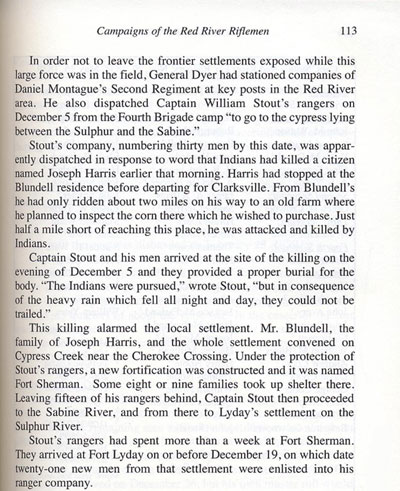
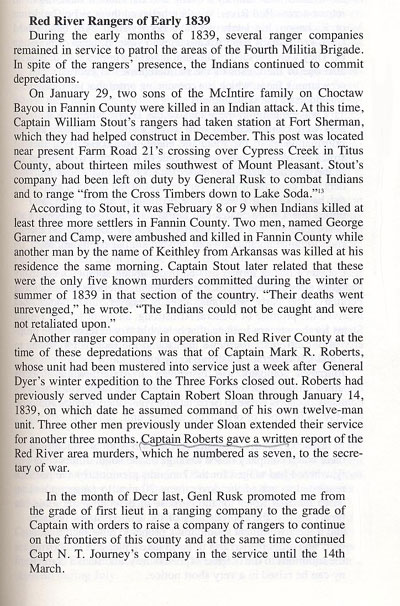
25-Fort Crawford
This fort (either family or Texas) was built near Hallsville in the lawless Neutral Zone between Louisiana and Texas in 1839, to protect settlers from Indians, renegades, and outlaws. The Neutral Zone was disputed land between Texas and Louisiana and attracted all sorts of criminals and bad characters. Sketches indicate that the fort may have been a military encampment with a two-story blockhouse built inside of a tall picket stockade fence that encircled the entire complex, it may have been a Texas Ranger encampment, or it may have been a family blockhouse enlarged by the Rangers. It did serve as a refuge for settlers when the Cherokee War broke out in 1839, although the supplies inside the fort were inadequate for the number of people there.
The number of families living in the fort was unknown but it was large enough for a traveling preacher to have delivered a sermon there. The site is on private property, and it is reported that there are no visible ruins of the fort.
26-Fort Le Dout
Reportedly located in what is now Wood County, this fort is one on which there has been little written, and very little known. The French had possibly established it during the 1700s as a post for trading with the Caddo and Wichita Indians. Le Dout may have been located on the Sabine River or possibly on Lake Fork Creek, a fort of the Sabine. A 1989 archeological study suggested that a site, located about five miles from the intersection of Lake Fork Creek and the Sabine River, may be the location. If so, Fort Le Dout may be beneath Lake Fork Reservoir.
63-Coleman's Rangers Attack Tawakonis
In July of 1835, Coleman's Rangers attacked a force of over one hundred Tawakonis in Limestone County. Coleman later wrote, "We had a severe battle. One fourth of my men was killed and wounded. We took their encampment by charge and the battle ended." They arrived back at Parker's Fort on July 11th.
64-Colonel Moore's Ranger Expedition
They departed Parker's Fort in early August and moved northeast toward the Tawakoni Village. Twenty miles over the prairie they came to Post Oak Creek, a tributary to the Trinity River.
The officers were strict about keeping the men in line. From Captain George Barnett's ranger company, Privates Samuel McFall and George Erath darted far ahead of the rest of the volunteers on their horses. It was not, however, by their own choice, as Erath recalled.
"I was riding a young horse which had been caught a colt from the mustangs, that was fiery. When the order came to charge, it darted forward ahead of all the rest, and I found myself alone in the advance. Next came McFall, who was also on a wild horse, too eager for the fray. The officers shouted to us to come back into line, but our efforts to obey were in vain. Our steeds had determined to give us a reputation for bravery which we did not deserve." Erath's daughter recalled that this incident even helped earn her father the nickname "The Flying Dutchman."
The Indians scattered but the Rangers continued the pursuit. Though several Indians were encountered, the only fatality was that Ranger Moses Smith Hornsby was accidentally killed by Ranger William Magill.
79-Anderson-Faulkenberry Slayings
January 28th, 1837, A six man Ranger party left Fort Houston in search of hogs. They gathered some hogs and sent them back with two of the rangers. The other four spent the night and waited for the other two to return with a canoe so they could work the other side of the river. The four were attacked by Indians. Colombus Anderson was hit by the first shot and mortally wounded. David Faulkenberry was shot but yelled "C'mon boys, it's time to go." With that, all jumped in and swam across the Trinity, in spite of their wounds. One Indian tale claimed that Faulkenberry fought like a wild man, killing two Indians and wounding a third. Though wounded and scalped, he threw himself into the river and swam to the middle, where he sank out of sight.
A couple of the above fort descriptions are from the book, Texas
Forts, by Wayne Lease.
Home | Table of Contents | Forts | Road Trip Maps | Blood Trail Maps | Links | PX and Library | Contact Us | Mail Bag | Search | Intro | Upcoming Events | Reader's Road Trips Fort Tours Systems - Founded by Rick Steed |

 Texas Forest Trail Region
Texas Forest Trail Region
